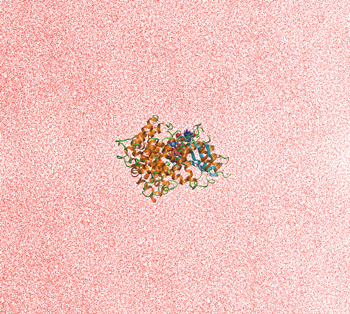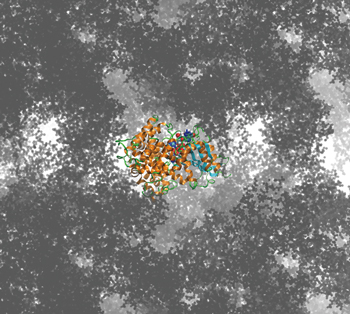Exploring a chemical reaction in an intracellular crowded environment by the QM/MM method


Fig. 1 :Ideal protein (Ras/GAP complex) floating in water (red dot: water molecule)

Fig. 2 :Ras/GAP complex in schematic cell environment (water molecules omitted. Gray dots represent other proteins)
Various chemical reactions continuously occur in the living body. Knowledge of those chemical reactions is essential to understand life phenomena and go further. The QM/MM method we use (a combination of quantum chemistry and classical physics to deal with a chemical reaction in a complex system with a high degree of accuracy) is a very important method to gain knowledge of a chemical reaction in a complex environment like a biological system. In 2013, Dr. Karplus, Dr. Levitt and Dr. Warshel shared the Nobel Prize in Chemistry for the development of the QM/MM method. It shows how important and promising it is.
Although the QM/MM method is a very excellent method to deal with chemical reactions, it has a problem of requiring very high computational capacity. Recently developed computers can now deal with an isolated protein floating in water (Fig. 1). However, their capacity is not sufficient to handle in vivo chemical reactions. For example, a real living cell is packed with various proteins (Fig. 2). It is much different from the too ideal environment shown in Fig. 1. However, conventional QM/MM computation does not take account of such a crowded cellular environment at all. On top of that, temperature is another important and sensitive factor for living organisms. Although thermal fluctuation of protein conformation always occurs, its impact has not been handled properly. However now, thanks to the K computer and other large-scale computers, QM/MM computation in the environment shown in Fig. 2 has become possible. We also can deal with temperature efficiently to some extent by the method our group has developed recently (QM/MM RWFE SCF method). Honestly speaking, how things change in the very complex environment shown in Fig. 2 has been poorly understood. Even imagining it is difficult, but now we can study it anyway.
Now we are studying the reaction by which GTP (guanosine triphosphate commonly found in functional regulation of a living organism) breaks down into GDP (guanosine diphosphate) in a system called the Ras/GAP complex in the environment shown in Fig. 2. Both Ras and GAP proteins are involved in canceration as well as in life. Although we have just started computing and there are many things we still don,t understand, we will discover, bit by bit, how a more realistic environment (temperature, crowded environment, etc.) works, and how things are affected by such an environment.
ZOOM IN Theme3 Multi-scale simulation of platelet aggregation in initial stage of thrombogenesis


















